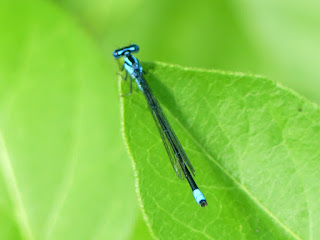A Bunch of Bluets
If all the IDs I got are correct [1], here are 3 different bluets I met last spring. Bluets are damselflies, and most of the time the males have some bright blue coloring. I will try and provide the rationale for these identifications:
- These damselflies are all about the same size, so even if they had agreed to be measured I might not be able to ID them from the measurement. The Skimming Bluet is 1.0-1.1", the Turquoise Bluet is 1.1-1.2", and the Slender Bluet is 1.2". And each of them has blue on abdominal segments S8-S9, which are the ones almost at the end.
- All these bluets are considered "common", so it wouldn't be surprising to see any of them in New Jersey. All of them are active in June. And although my field guide suggests that the Slender Bluet isn't in Somerset County, 1) They are known to be in the counties north and south of Somerset County, and 2) My field guide is from 2009, so it might not reflect the exact location of current populations.
- Probably the best differentiator can be seen in the 3rd 1, the Slender Bluet. If you look at the thorax (between the head and the abdomen, and where the wings are attached) you can see that it's blue with very thin black lines compared to the other 2, a trait of the Slender Bluet.
- The next differentiator is a little subjective. If you look at the 1st picture, the Turquoise Bluet, you'll see that the abdomen is almost black between the thorax and segments S8-S9. And in the 2nd picture, the Skimming Bluet, you'll see somewhat more prominent blue rings where the segments meet (until you get to the blue segments S8-S9).
You might wonder about hybridization among a bunch of similar looking species occupying similar habitats, especially since some odonate males will try and drive off vaguely similar males of other species as though they were breeding rivals. One thing that's suspected to prevent this (at least a lot of the time) concerns the way odonates breed. The male will use claspers at the end of his abdomen to grab the female behind the head; that clasping action might not happen correctly across species.
 | |
| Turquoise Bluet June 13, 2023 at Washington Valley Park Photo 300986985, (c) jpviolette, some rights reserved (CC BY-NC) |
 |
| Skimming Bluet June 13, 2023 at Washington Valley Park Photo 300987254, (c) jpviolette, some rights reserved (CC BY-NC) |
 |
| Slender Bluet June 13, 2023 at Washington Valley Park Photo 300988361, (c) jpviolette, some rights reserved (CC BY-NC) |
[1] All these got some support and no dissent from iNaturalist.



Comments
Post a Comment